Introduction–
Table of Contents
In the present time, in the world of hectic lifestyles and competition, the work culture is changing day by day. New digital technology, the internet, and globalization have changed the entire working system in a completely new form. Earlier, employees could work only in the office under the traditional working time of 9.00 a.m.–5.00 p.m., at the prescribed time, at a fixed place, and according to the routine, which has been a part of the work culture of any office or business organization for a long time. At the same time, many types of concepts, such as remote work, hybrid model, and flextime manager, have become their main methodology.
Nowadays, due to the busy schedule, under the changing nature of work culture, everyone’s lifestyle, responsibilities, circumstances, and working style have become different. It is easier for some to work in the morning and for some at night. But the process of working together at the same fixed time, at the same place, is no longer possible due to the imbalance in personal and professional life. Because of this work culture, employees not only experience stress but also reduce their productivity and work efficiency. In addition, punctual visits and rigid policies of the organization affect both employee satisfaction and work balance.
In such a difficult situation, for everyone, FlexTime Manager is a method that makes the entire traditional working style flexible, streamlined, and transparent to solve all these problems.
What is FlexTime Manager?

FlexTime is a work system or modern tool that gives all team members or employees the freedom to schedule their work time according to their personal convenience, health, and daily task preferences, but to adhere to the work hours they set and the “core time” required by the organization. It not only provides physical and mental balance to the employee but also increases productivity and satisfaction for the organization. Flex time is mainly divided into two parts.
A- Core Time- The fixed time in which the attendance of all employees is compulsory, so that meetings, teamwork, and necessary coordination work can be done smoothly. For example, from 11.00 am to 2.00 pm.
B- Flexible time- The remaining time, other than the core time, in which the employees can complete the work as per their convenience, by doing the work set by them. For example, one employee can start work at 7.00 a.m. and finish it by 2.00 p.m., while another may start at 10.00 a.m. and finish it by 4.00 p.m.
In the last few years, due to the global pandemic like COVID-19, due to the entire technological advancement, and the entire process of the work environment, there has been a major change in the work culture. Globalization, remote work, and the increasing use of digital tools have completely changed the entire traditional working system.
Now people are beginning to see the result of the work, more than just the working time. During this change, the concept of the flex time manager has become increasingly popular to streamline the entire process. It is a system that helps to flexibly streamline the work style, create schedules, track time, and prepare reports. It provides freedom to all employees to choose the time and place of work as per their convenience, in addition to the prescribed core time. This improves the work balance, increases productivity, and also gives the organization a more skilled workforce.
FlexTime Manager, therefore, is not just a time-management tool, but a work-culture innovation that balances the needs of both employees and organizations.
The major objective of this blog is to give detailed information about Flex Time and Flex Time Manager. Such as What is Flex Time Manager, Need, Role, Main Functions, Benefits, Challenges and Solutions, Steps to Implement, Tips for Success, Real-Life Examples, Its Importance in the Future, etc.
Why is FlexTime Manager Necessary?
In today’s hectic lifestyle, fa lex time manager has become not just a convenience but also a necessity and the biggest priority. Several important reasons for this are as follows.
1. Changes in Lifestyle and Work Balance-

At this time, people have started giving priority not only to jobs but also to family, health, and personal development. Flex Time Manager helps employees to have a better balance of their time, thereby reducing mental stress and increasing the quality of life.
2. Global Teams and Different Time Zones-
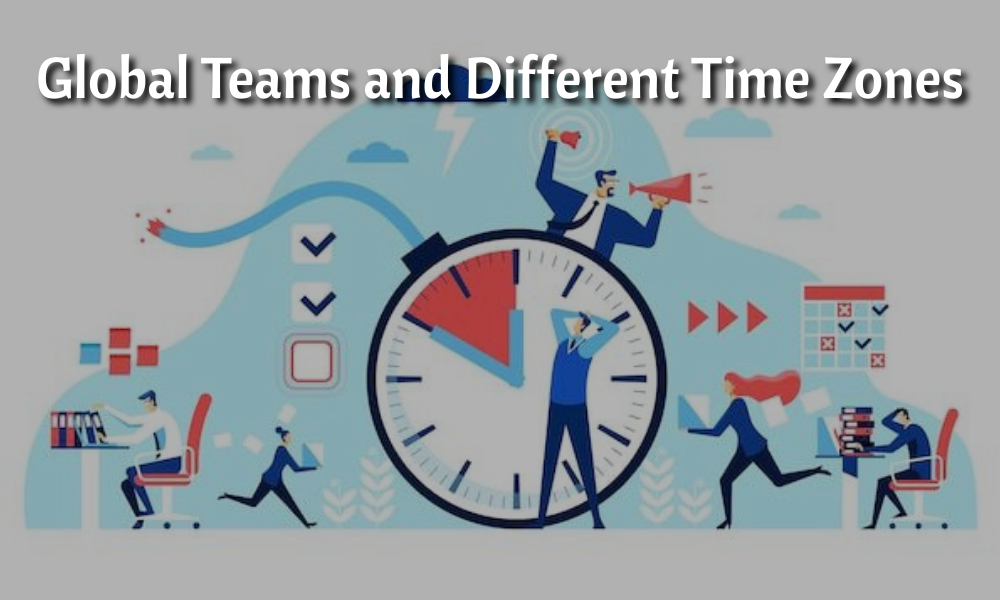
In many multinational companies, employees from different countries work together. In the traditional working hours of 9.00 a.m.–5.00 p.m., it is impossible to reconcile everyone at the same time. With a flex time manager, team members can contribute to each other according to their time zone, which increases the spirit of collaboration and productivity among themselves.
3. Technological Development and Remote Work Culture-
Cloud tools, video conferencing, and project management software have made it easier to work simultaneously from multiple countries.
4. Satisfaction and Durability of Employees-
Under flex time managers, employees feel that the organization understands their needs and gives them importance. This experience not only increases their satisfaction but also helps in sustaining talented employees for a long time.
Thus, Flex Time Manager is a solution for the modern work culture that empowers the value of the employee, the efficiency of the organization, and the global work culture.
Key Features of FlexTime Manager-
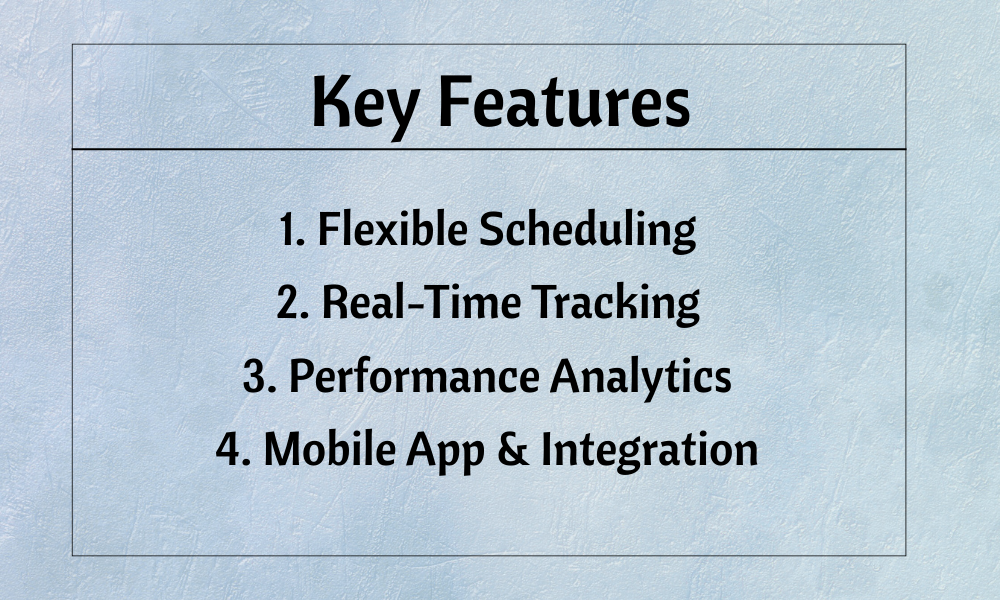
FlexTime has several useful features that set it apart from traditional time-tracking tools. As-
1. Flexible Scheduling-
Flexible scheduling provides employees with the freedom to choose working hours as per their convenience and productivity. Some like to work early in the morning, some like to work late in the evening. FlexTime helps to prepare schedules, keeping this diversity in mind. This makes the employee satisfied and the organization stronger.
2. Real-Time Tracking–
With the help of flextime, management gets to know which employee is working on which project at what time. This feature is not just limited to registering attendance, but also gives instant updates on the work in progress. This reduces wastage of time and makes teamwork more transparent.
3. Performance Analytics-
This tool provides various reports and dashboards from which managers can easily see what level employees and teams are working on. With its help, the organization determines which areas need improvement and which areas are using resources properly.
4. Mobile App & Integration-
FlexTime’s mobile app allows employees to log in, track time, and view updates from anywhere. Additionally, it integrates with HR, salaries, and project management tools to make the entire system easy and smooth.
So Flex Time Manager, due to all these features, is not just a tool for time management, but a complete smart work management solution.
FlexTime Manager’s Helpful Resources-
If you want a personal flex schedule planner, I can help you. You can get a variety of Planners with the help of the latest website vijaybooks.store. Other blogs related to this are also available.
There is also another blog equivalent to this blog.
Benefits of FlexTime Manager to Employers–
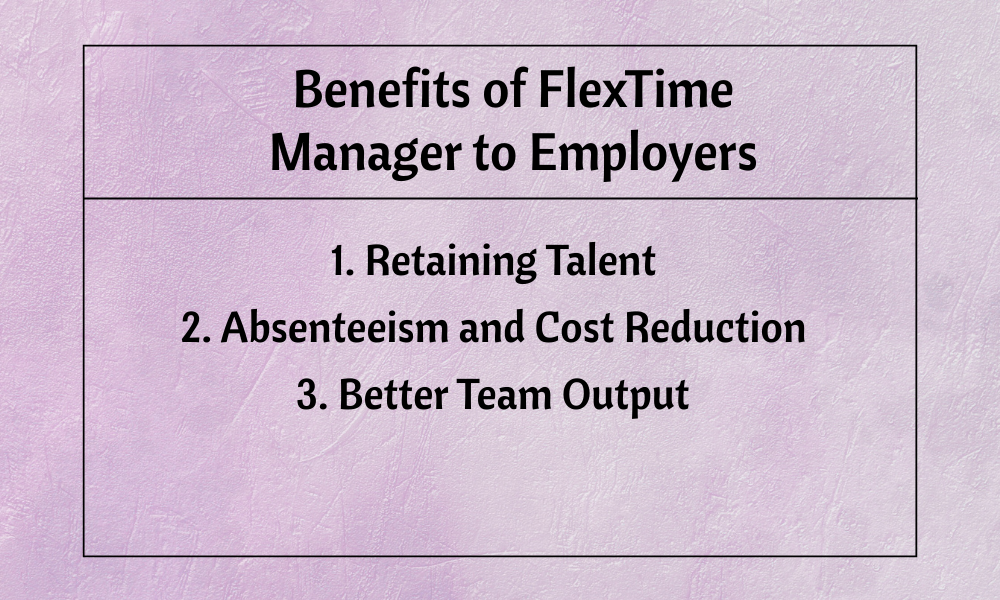
1. Retaining Talent-
Organizations that offer flex time can keep their employees engaged for a long time. When employees get the freedom to control their time and work according to their productivity, they remain more loyal and motivated towards the organization.
2. Absenteeism and Cost Reduction-
Flexible timings reduce the need for employees to take sudden vacations, thereby decreasing absenteeism and increasing productivity. Additionally, FlexTime Manager automates attendance, overtime, and leave management. This makes teamwork easier and allows them to focus on strategic tasks.
3. Better Team Output-
Satisfied and motivated employees perform better in teamwork. By taking advantage of flex time, they complete their work on time and also maintain quality. Along with this, the FlexTime Manager tool helps companies save time and cost.
Thus, the flex time manager tool is certified as a strategic asset for employers.
Benefits of Employees from FlexTime Manager–
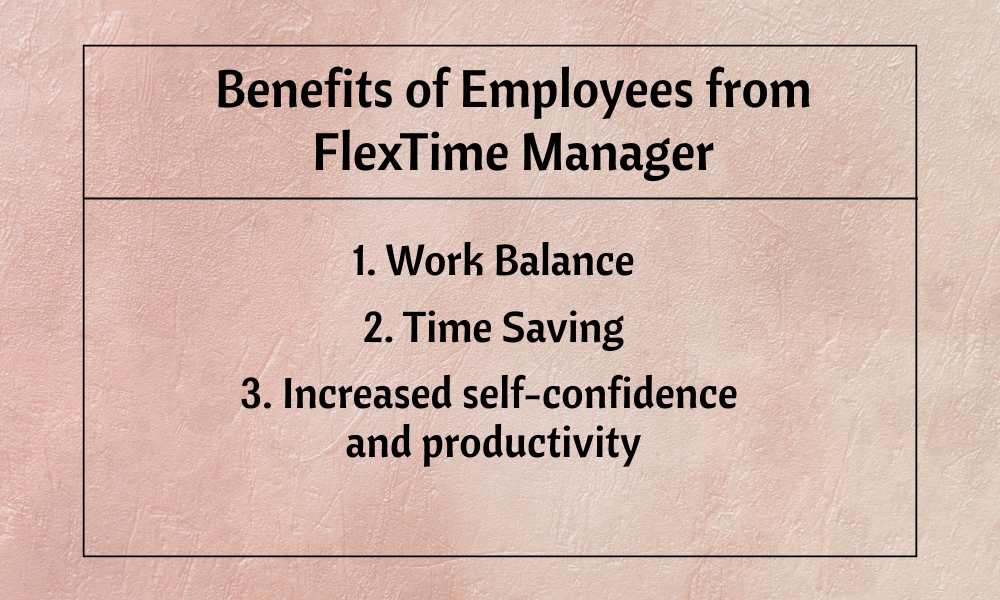
Flextime managers bring many benefits not only for employers but also for employees. First of all, it helps to reduce stress. Employees often feel mental fatigue due to the pressure of fixed deadlines and rigid shifts. But when they get the freedom to work as per their convenience, their stress decreases, and they can work in a more positive environment.
1. Work Balance-
Flex time managers allow employees to strike a better balance in their personal and professional lives. They can make time for family, health, and personal interests, which reduces stress and increases the quality of work in life.
2. Time Saving-
Through this, employees can avoid traffic and save time commuting. They can spend their time relaxing, learning, or engaging in other creative activities.
3. Increased self-confidence and productivity-
When employees work under a flex time manager, they are more focused and energetic towards their work. This not only increases their confidence but also increases satisfaction with the work.
A flex time manager, therefore, not only provides independence and balance to his employees, but also makes the organization more stable, productive, and competitive. Along with this, this tool helps in career development. When employees are able to analyze their efficiency and time, they try to further improve their skills. This speeds up their professional development and keeps them ready for future challenges.
Steps to Release FlexTime Manager-
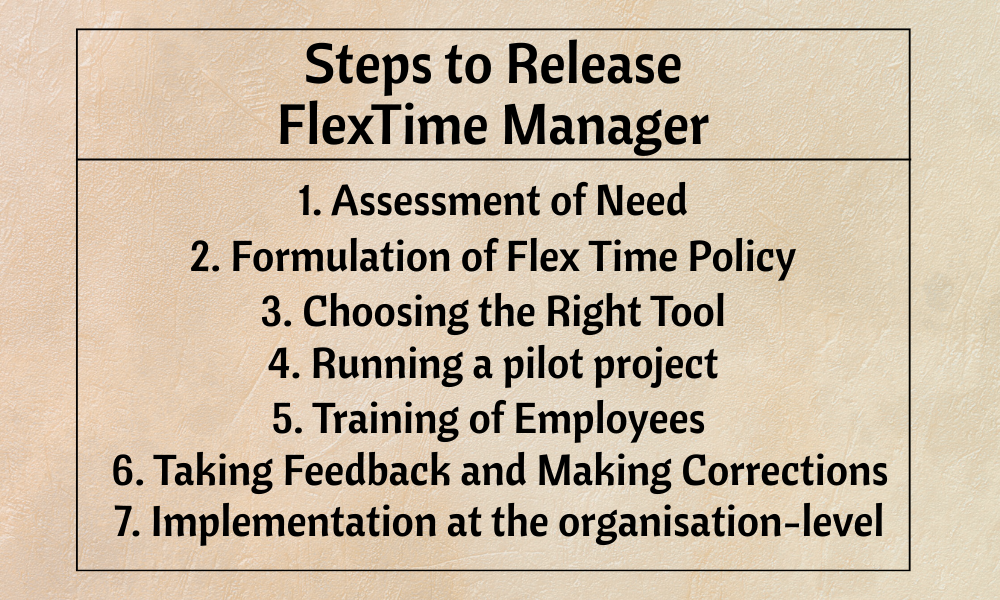
In any organization, a well-organized, well-thought-out, and stepwise strategy is required to successfully implement a flextime manager. It’s not just a matter of installing tech tools, but the process of adopting a new work culture. The main steps are given below.
1. Assessment of Need-
First of all, it is necessary to understand why flex time is needed in the organization. Are employees feeling a lack of work balance? Is there difficulty in coordination due to different time zones or remote work? This assessment makes it easier to choose the right policy and tools.
2. Formulation of Flex Time Policy-
Before implementing flex time, a clear policy has to be formulated, which should include core time and flexible hours, rules of leave and overtime, criteria for performance appraisal, etc. The policy must reach all employees in writing.
3. Choosing the Right Tool-
Choose flex time manager software suitable for time tracking, scheduling, and reporting, such as Clockify, a simple tool for small organizations, feature-rich tools for large organizations, such as BambooHR, or Zoho People.
4. Running a pilot project-
Before releasing it to the entire organization, run it on a trial basis in a department or team and see how the policy and tools are working in practice. Identify and address early challenges.
5. Training of Employees-
For this, give full information to all employees about the use and policies of the new system. Training through workshops, video tutorials, or demos. Teach the manager and team leader about the additional responsibilities and advanced features of the tools.
6. Taking Feedback and Making Corrections-
For this, take feedback from employees and managers after the pilot project. What tools are easy to use? Has time management and productivity improved? Make changes to policy or tools based on these responses.
7. Implementation at the organisation-level-
For this, when the system and policy are stabilized, release it to the entire organization. Provide continuous support during rollout. Keep updating the system by reviewing it from time to time.
Challenges and solutions related to FlexTime Manager-
However, FlexTime Manager is a powerful and effective solution for modern work systems. But there are a number of practical challenges in issuing it. If these are not resolved in time, it turns into flex time chaos.
Key Challenges-
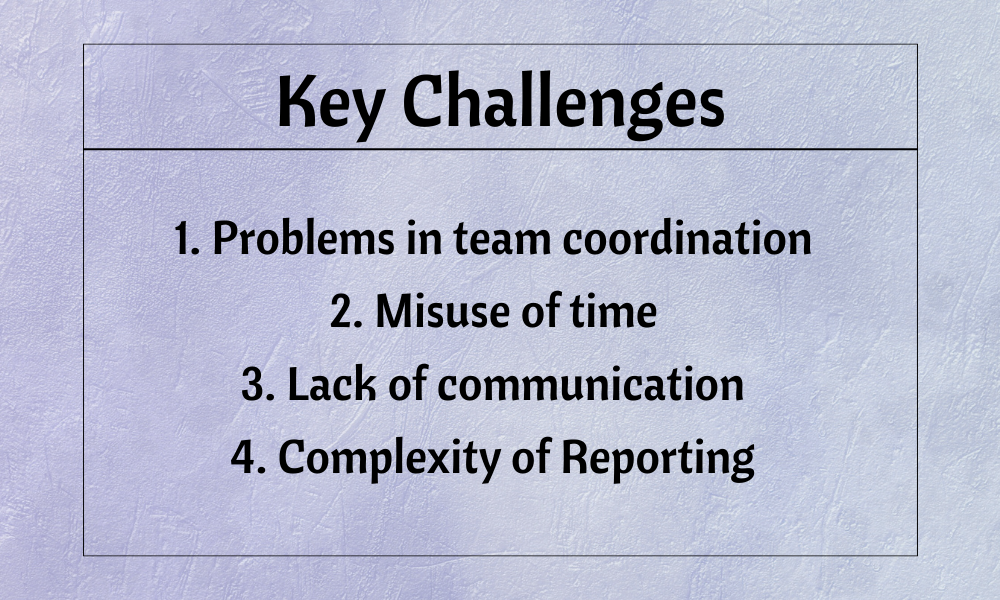
1. Problems in team coordination-
When team members work at different times and places, it becomes extremely difficult to coordinate meetings, decision-making, and collaborative work.
2. Misuse of time-
Some employees do not utilize flexible time properly and keep procrastinating work, which affects both deadlines and quality.
3. Lack of communication-
Not being online or in the office at the same time can delay communication and hinder the exchange of information.
4. Complexity of Reporting-
Tracking the work hours, progress, and attendance of employees working in different schedules becomes extremely difficult with traditional methods.
Solution by FlexTime Manager-
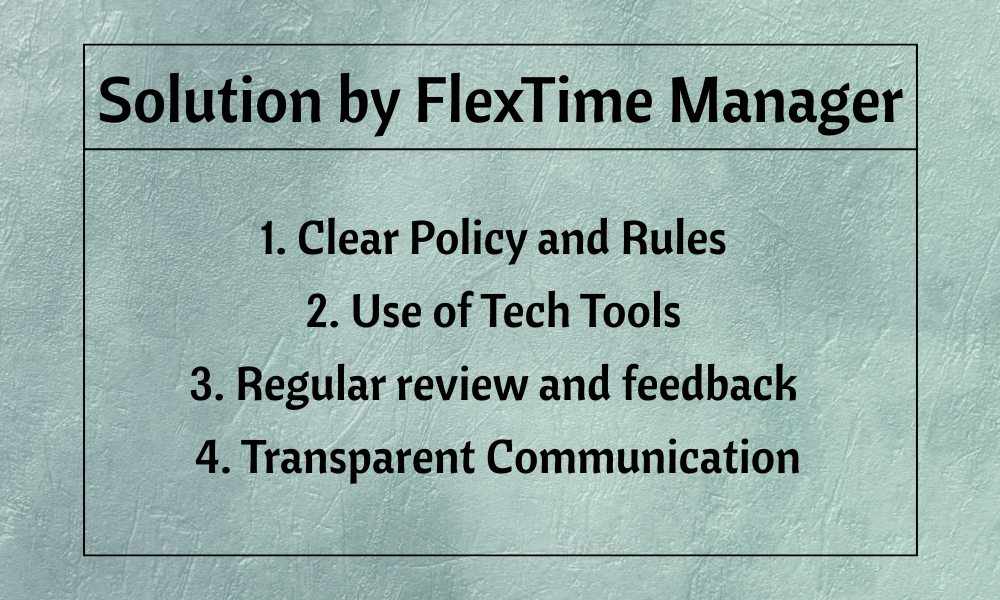
1. Clear Policy and Rules-
Core time, total working hours, leave procedures, and approval rules should be set in advance, so that everyone’s expectations are clear.
2. Use of Tech Tools-
Task management can be simplified using time tracking, scheduling, and project management tools such as Clockify, Zoho People.
3. Regular review and feedback-
On a weekly or monthly time basis, review the data to assess how effective the flex time policy is and what areas need improvement.
4. Transparent Communication-
Promote an open communication culture in the team, so that each member knows who, when, at what time, and what work is in progress.
So the success of a flextime manager lies not only in flexibility, but in discipline, the right use of technology, and transparent communication. A competent flex time manager can turn these challenges into opportunities.
Future Role of Flextime Manager-

In the coming years, Flex Time Manager will not just be a tool for time management, but will become a smart Artificial Intelligence (AI)-powered partner.
1. Artificial Intelligence (AI) and Machine Learning-
The algorithms will automatically generate schedules based on staff availability, productivity patterns, and project priorities. This will save time for manual planning and maximize the use of resources.
2. Integration into Virtual Workplace-
As workspaces are becoming cloud-based and virtual, Flex Time Manager will be integrated directly into collaborative tools like Microsoft Teams, Slack, and Zoom, so that scheduling, communication, and reporting can happen on a single platform.
3. Real-Time Performance Tracking-
Flex time managers in the future will track employees’ activities, project progress, and productivity in real-time, enabling instant feedback and decisions.
4. Importance in Hybrid Work Culture-
In the hybrid model, flex time will become the central means of maintaining a balance in manager, team attendance, meeting time, and collaborative tasks.
Hence, in the future, flex time managers will be a smart, integrated, and real-time decision-making system, making organizations more flexible, efficient, and competitive.
FlexTime Manager: Case Study
IT Company Experience- A mid-range IT company released a FlexTime Manager, so that developers can work according to their productivity. As a result, the employee satisfaction rate increased by 30% and the project delivery time was reduced by 20%. This kind of flexibility gave them a chance to be stress-free, improve their coding, and team collaboration.
Example of a small business- A startup retail firm had to work with a limited budget and a small staff. HR functions such as attendance, payroll, and leave management were automated after the adoption of flextime managers. This saved both time and cost and allowed owners to pay more attention to business development.
Use of Remote Team- The team of a digital marketing agency was working in different cities and multiple countries. The flextime manager gave them real-time tracking and project-based reports. With this, the management started to see the progress of all the team members clearly, and the projects were completed on time.
It is clear from these examples that whether a large company, a small business, or a remote team flextime manager is a useful tool for increasing flexibility and productivity in every type of organization.
FlexTime Manager: Conclusion
In today’s time, the relevance of a flextime manager is greater than ever. Unlike the traditional work model that tied employees to rigid schedules, flextime managers offer flexibility and allow them to lead more independent and balanced lives. This not only strengthens employee satisfaction and work balance but also opens the way for productivity and better utilization of resources for organizations.
The basic philosophy of this system is balance and responsibility. While employees get the freedom to work according to their choice and productivity, they are expected to understand their responsibilities and fulfill organizational goals. In this way, FlexTime Manager presents the perfect blend of both freedom and discipline.
In the future work culture, flextime managers can become a complete solution for organizations. With advanced features such as AI, automation, and wellness, it will help companies create a more attractive and competitive workplace. The flextime manager can become the basis of the success and growth of modern organizations, not just a tool.

